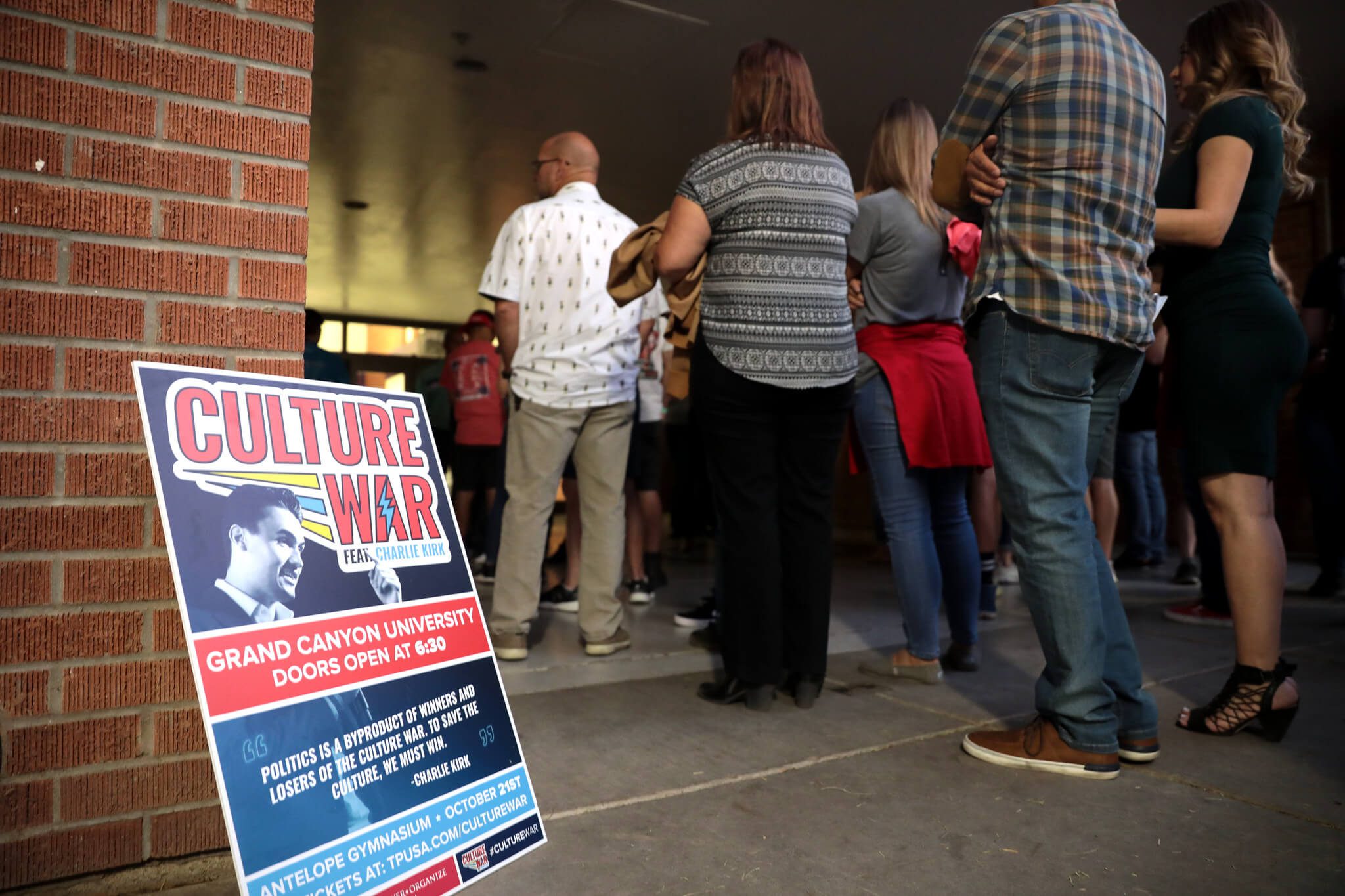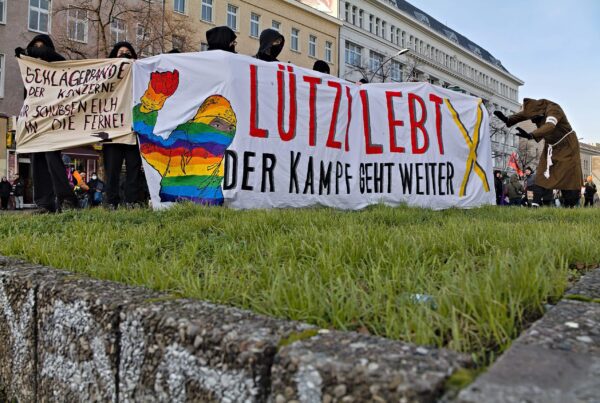The German language is known for its word-monsters. Some of its words, however, have entered the dictionaries of other languages. Kulturkampf is one such term, even if it is globally understood as meaning “culture war” rather than the literal translation “culture battle.” Coined by Rudolf Virchow in 1873, Kulturkampf characterizes the cultural struggle of German chancellor Otto von Bismarck, a Protestant, against the German Catholic Church between 1871 and 1885. Through the closure of Catholic institutions, he attempted to eradicate the influence of the Catholic Church in the newly created German Empire, which included the predominantly Protestant Prussia and was governed by a predominantly Protestant elite. In similar fashion, the U.S. socio-political landscape was long shaped by a Protestant-Catholic (plus Jewish) divide: when the Protestants colonized America, they brought anti-Catholicism with them. Through the middle of the twentieth century, as McTague and Layman explain, northern Protestants formed the backbone of the Republican coalition, while Catholics, Jews, black Protestants, and Southern Protestants tended to support the Democrats.
The Conceptual Nature of Culture Wars
The U.S. sociologist James D. Hunter, aware of the history of the German Kulturkampf, described moral-political conflicts in the US since the 1970s as Culture Wars. In his view, the Protestant-Catholic cleavage was being replaced by a division between religious believers and increasingly secular adherents of, on the one hand, progressive and, on the other hand, traditionalist values. This “impulse towards progressivism” and towards “orthodoxy,” he believed, would cut across religious denominations and political camps. With this theory, he sought—as the subtitle of his book indicates—to “make sense of the battles over family, art, education, law and politics.”
The Culture War concept relies on three main assumptions. First, it is no longer the religious background—whether Protestant, Catholic or Jewish—of voters, presidents or lawyers that tends to polarize people, but rather their “particular locus and source of moral truth, the fundamental […] moral allegiances of the actors” and their progressive or orthodox “cultural and political dispositions.” That observation corresponds with comparative research into religious fundamentalisms conducted by Appleby & Almond and Brekke since the end of the 1980s, which found that the traditionalist, literal, selective reading of religious texts first identified in American Protestant fundamentalism exists in every religion worldwide. It is thus not any given religion but religious interpretation that may trigger harsh opposition to progressive abortion or partnership laws or to sex education (Almond et al. 2003; Brekke 2011).
Second, and in this vein, much like progressive wings of Protestantism, Catholicism, and Judaism, orthodox wings are forming alliances to counter the “influence the other seeks to exert in public culture.”
Lastly, and most importantly, in the US these battles are not simply about diverging views on abortion, homosexuality or education. They are also closely intertwined with a battle over the “meaning of America,” about how we order our lives together, the nature of community, and, thus, national identity.
Hunter wrote his seminal book Culture Wars: The Struggle to Define America in 1991. At that time, the United States was experiencing the rise of the Moral Majority, the earliest Christian Right movement, which successfully supported Ronald Reagan´s presidential campaign in 1980. Founded by the televangelist Jerry Falwell in response to progressive moral political developments since the 1970s, the Moral Majority quickly grew into a Baptist-dominated non-denominational Christian movement against gay rights, the right to abortion, contraception, sexual education, etc. As Wald and Calhoun-Brown show, even though the Moral Majority ultimately disappeared as a movement, since the 1980s the Christian Right Movement became stronger over time.
Nowadays, the term “Culture Wars” is commonplace in titles and headlines. Why is that? I will approach this question through the lens of my own research and by looking at contemporary debates and developments.
Morality Policy Analysis
Trained in comparative politics and interested in the relationship between religion and politics in post-secular Europe, I conducted qualitative research aimed at explaining why predominantly Catholic Poland, Italy, and Spain differed in their policy output regarding the regulation of abortion, artificial reproduction, and (homosexual) civil partnership laws. At a more abstract level, the study aimed to identify general patterns and contextual structures affecting the interplay between religious and political actors in Europe, where religious adherence has been declining for decades but where the institutionalized relationship between Church and state has nevertheless remained cooperative. Hunter’s book was a relevant reference for such type of value conflicts where religious actors are involved.
Then I came across the “morality policy” concept. In his edited volume The Public Clash of Private Values: The Politics of Morality Policy, the U.S. political scientist Christopher Z. Mooney collected analyses of U.S. battles over reproductive rights, gay rights, prostitution, gun control, and gambling since the era of the Reagan administration to elaborate on Meier’s concept of “morality policy.” The central idea was perfectly applicable to the European post-Cold War context: whereas Hunter’s analysis centered on the worldviews and coalition-building of likeminded religious and political actors in a public sphere where religious arguments are widely accepted, Mooney and his contributors concentrated on morality policy as a specific policy field, a conflictual political arena where (in principle) no material resources are distributed but behavior is regulated:
Morality Policy appears to move us out of the realm of facts and reason, where social scientists and especially political scholars feel comfortable, and into the realm of values […]. To understand policy making at the turn of the millennium (at least in the United States and other Western democracies), however, one must understand the politics of morality policy (Mooney 2001, 5).
“Politics of morality policy” refers to the assumed particular conflictual character of the policy process surrounding morally sensitive issues, where religious actors are more involved than in other policy fields, where often incompatible worldviews clash, and thus where finding a compromise seems impossible—characteristics that clearly applied to the moral-political processes in Poland, Italy, and Spain, as well as in other parts of (Catholic) Europe, where, since the 1990s, legal initiatives to implement more permissive laws regulating behavior have been provoking harsh political controversies.
Interestingly, 2012 witnessed the arrival on the academic scene not only of my book (in German) Morality Politics and Religion: Conditions for Religious-Political Cooperation in Poland, Italy, and Spain, but also of the well-composed volume edited by Isabelle Engeli, Christopher Green-Pedersen, and Lars Thorup Larsen, Morality Politics in Western Europe: Parties, Agendas, and Policy Choices. A year later followed articles from Christoph Knill, a German political scientist who had won an EU grant to analyze the pattern of morality politics in Europe, and his team (Knill 2013; Knill et al. 2014; Euchner 2019). Whereas the concept of “Morality Policy” made its breakthrough in European academia, “Culture Wars”—while addressing similar values conflicts—was apparently considered rather an American phenomenon. Moreover, despite the popularity of the metaphor, Hunter has also been met with skepticism, as other scholars have doubted the existence of orthodox and progressive alliances in politics. Others have seen no evidence for wars, as most Americans would not have been interested in these conflicts.
In recent years, however, the term “Culture Wars” has experienced a revival, while morality policy approaches have largely remained confined to political science research. How can we explain the success of the term “Culture Wars”? And to what extent it is applicable to non-U.S. contexts?
Culture or Politics or War?
In May 2021 Politico published an interview with Hunter, now director of the University of Virginia’s Institute for Advanced Studies in Culture. Reflecting on the storming of the Capitol on January 6, 2021, he highlighted a relevant point for understanding “Culture Wars,” namely that these battles are always about both politics and culture, as they involve “(t)he mobilization of political resources—of people and votes and parties—around certain positions on cultural issues. In that sense, a ‘culture war’ is really about politics.” At the same time “deeper cultural dispositions”—not just attitudes and values—shape politics (Hunter, quoted in Politico). Empirically, one could study the intermingling of religious interpretations and processes of moral political regulation as a Culture War. Hunter suggests focusing more on “climatological changes” in terms of societal polarizations—changes that are “animating dynamics within democracy right now” (Hunter, quoted in Politico). Culture wars thus simultaneously shape and reflect how a society (the US) (re)defines its fundamental values.
Given the uncomfortable war metaphor, it may come as no surprise that neither in 1991 nor today has Hunter excluded the possibility of violence erupting: “Culture wars always precede shooting wars. They don’t necessarily lead to a shooting war, but you never have a shooting war without a culture war prior to it, because culture provides the justifications for violence” (Hunter, quoted in Politico).
Has Europe experienced shootings around moral-political conflicts? Admittedly, culture, religion, and national identity played a fundamental role during the war in the former Yugoslavia about the geopolitical hegemony of ethnic identities. But to consider this war a Culture War would probably overstretch the concept.
Since February 24, 2022, however, in the context of the ongoing Russian war against Ukraine, Putin´s brutal moral-political choreography of the last decade has been cast in a new, dark light. How much culture is in that war? As Kristina Stöckl, an expert on Russia, the Orthodox Church, and their joint defense of traditional values, wrote with Dmitry Uzlaner, Putin attacked Ukraine with the support of Patriarch Kirill because both find the West—with its liberal rights and values—“decadent.” The “Gayropa” narrative was born to construct a line between the “liberal decadent West,” which has since the Euromaidan in 2014 included Ukraine, and a “traditionalist Russia,” then mobilize the population for a fight along that line. This fight is apparently also a competition over the meaning or re-conceptualization of Russia in an ideological and geopolitical sense.
Structural Differences
Even if the moral-political issues at stake are similar in the US and in Europe, to what extent do such conflicts define the meaning of a nation in European states? In Poland and Hungary, for instance, where anti-gender politics have helped to create strong alliances between Catholic orthodox think tanks and the government against the Council of Europe’s Istanbul Convention on Violence against Women and Domestic Violence, opposition to the Istanbul Convention has been framed by the two countries’ governments as a duty to respect the national constitution and identity. Europe in this context, as discussed below, has become a reference for Christian traditional values e.g. in opposition to EU gender equality politics.
A clear contextual difference between Europe and the US is the role of religion in social and public life. In Europe (unlike in the US), declining Christian religiosity and ongoing conflicts over religious symbols in the public sphere coincide with little tolerance for or tradition of religious rhetoric in the public sphere. In the US (unlike in Europe), the constitutional separation between church and state has helped to create a vivid and diverse landscape of independent religious institutions and congregations.
There is also a stark contrast between Europe and the US when it comes to non-governmental structures. In Europe, state co-funding exercises greater control over the nonprofit space, whereas in the US, “a lot of our charitable money—which is a massive amount compared to other countries—gets channeled through these charitable organizations that exist with a take-no-prisoners policy; that define the enemy, that define a devil, that define transgressions in certain ways” (Hunter, quoted in Politico).
The last decade, however, as Datta’s reports reveal, has seen the establishment of myriad NGOs and think tanks (mostly affiliated with the Catholic Church) that—like the Polish or Croatian Institute for Legal Culture Ordo Iuris, with its economic and ideological links to the Brazilian Catholic fundamentalist “Tradition-Family-Property” organization—seek to sway the legal system according to their illiberal values. Some scholars are already speaking of a Christian Right in Europe. A forthcoming book attempts to grasp Christian-affiliated European NGOs’ increased organized political resistance to permissive reproductive rights, as well as to gender-sensitive political measures such as anti-discrimination programs in school curricula, transgender rights or the “old” demand for same-sex-partnerships, a development that has been accompanying the rise of the radical right in Europe for more than a decade.
Despite a trend toward converging morally illiberal lobby structures in Europe, my sense is that the institutionalized and resourceful resistance in the US makes Culture Wars still more powerful there. Structural differences notwithstanding, to what extent can we see a convergence of conflict patterns between European states and the US that explains (or even justifies) the increased use of the Culture Wars metaphor?
What Has Changed?
To begin with, Hunter points to a shift within the U.S. context from a “cultural conflict that took place primarily within the white middle class” to a “kind of class-culture conflict that has moved beyond the simple boundaries of religiosity.” More precisely, he argues that the fight against abortion since the 1970s has been replaced by race, as “race was never a very prominent part of that conflict.” He explains, “[Nowadays,] it is a position that is mainly rooted in fear of extinction. It is about race” (Hunter, quoted in Politico).
In June 2022, one year after Hunter’s interview, the U.S. Supreme Court overturned the Roe vs. Wade ruling that had guaranteed, since 1979, a constitutional right to abortion—a landmark ruling for the pro-life alliance. It might be that in cultural battles in the US today, it is race and not abortion that tends, in Hunter´s sense, to define the meaning of the US. The demand for LGBT+ and permissive reproductive rights, however, continue to polarize parts of American society and fuel power-political competition. This can be seen in Democrats’ unsuccessful fights to fill vacant Supreme Court positions in recent years.
Transnationalization and Liberal Hegemony
What has really changed is that the Culture Wars have become globalized and are increasingly framed as fights for family rights. The U.S. Christian Right developed its pro-family narrative for such fights back in the 1970s, but in more recent years, Russian actors have also become key forces therein. The most prominent example of a U.S.-Russian alliance fueling a global Culture War is the World Congress of Families.
My 2012 book mentioned two phases of value conflict in post-war Europe. The first phase is more global, marked by fierce national responses to the availability of contraception—which allowed “sex without reproduction”—and extending to the first fights over abortion and gay rights. The second phase is more European, as the reconfiguration of Church-state relations in Central and Eastern Europe after the Cold War went hand in hand with a re-negotiation for more permissive rules in Western and Southern Europe, while new possibilities of embryonic engineering challenged politics everywhere.
A third phase might now be the transnationalization of moral-political conflicts or Culture Wars, whichincludes the building of transnational issue networks such as Agenda Europe, One of Us, or the aforementioned World Congress of Families; the creation of lobby structures in Brussels; and, thus, the formation of multi-level alliances across political systems and secular or religious cultures. In this phase, nothing less than the hegemony of the liberal project—with its principles of individual autonomy, cultural pluralism, and equal rights—is contested, due especially to the widespread contestation of the hegemony of liberal values. I would not call it an Americanization of Culture Wars, despite the “old” question of life-and-death matters and the prominent role of U.S. actors in that process. Rather, we are facing a new generation of transnational conflicts where nothing less than the meaning of socio-cultural liberalism for Europe is at stake.
Although the contestation of the liberal project—or, as a new research consortium calls it, the liberal script—displays similar features, the dynamics, salience, and impact of such battles at the national level clearly vary due to differences in legacies and political structures. Relevant legacies relate to the pattern of Church-State relations and the public role of religion, to communism, and to EU-accession processes, as well as to current (individual) experiences with neoliberal transformations or the presence in government of right-wing parties.
Culture Wars or Morality Politics?
It has become clear that with the global shift toward anti-gender politics, accompanied by secular legal narratives designed to safeguard the traditional family and children against gender-ideological indoctrination, the character of moral-political battles has changed worldwide. From a comparative perspective that looks at policy output, however, illiberal opponents to progressive legal changes have been more successful in the US than in Europe due to differences in their religious-political contexts, lobbying structures, and access to political power. However, we may start to see the spread across Europe of similar illiberal developments covering politics and culture. Indeed, widespread use of the term Culture War suggests we are already there.
As such, returning to the questions laid out earlier in this paper, the Culture War concept seems to be applicable to cases in Europe (or even beyond) when it comes to conflicts over life/lifestyle-and-death matters like LGBT+ rights, reproductive rights, and assisted suicide, as well as sex education or prostitution. For an empirical or even comparative analysis of moral-political conflicts—their actors, (religious) ideologies, and strategies—the morality policy approach offers a more precise toolkit. The Culture Wars approach lacks the output-oriented analytical clarity of the morality policy approach, but it does identify a category of conflicts between liberal and illiberal worldviews over “culture” and over politics, the latter “primarily fueled by divisions on those issues, with leaders gaining power by inflaming resentments […]” (Hunter, quoted in Politico). In this light, the two approaches arguably complement each other: whereas the entanglement of political power and culture may be better analyzed as a morality policy conflict, the reasons why such conflicts come into existence and the social effects thereof may be better explained or studied through the lens of Culture Wars. To simply label conflicts as Culture Wars does nothing but dilute the term.
Gender, Race, Class
I will end with a self-critical reminder to encourage more reflective research. Hunter sees “race” as the most relevant Culture War issue in the US today. The European analogues could be Islamophobia, anti-immigration sentiments, and even antisemitism—a Culture War, horribly enough, fought by individual armed radicals. The perspective of intersectionality teaches us that the positionalities of race, gender, religion or class do not exclude and even reinforce each other. Heterogenous protests against COVID-19 in various countries exemplify such categorial assemblage. Another example could be anti-gender protests among voters for right-wing populist parties. They may display more class-related anti-establishment opposition than a religiously grounded fear of the “dissolution of heterosexuality,” yet the latter should also be taken into consideration. The Culture War concept, moreover, assumes a dichotomic conflict between traditionalists and progressives. To avoid an oversimplification or even essentialization of conflicts as black and white, researchers should seek to untangle their complexity—even through the lens of Culture Wars and probably with a (more precise) morality policy analysis.
Photo: “Culture War sign” by Gage Skidmore licensed under CC BY-SA 2.0.







